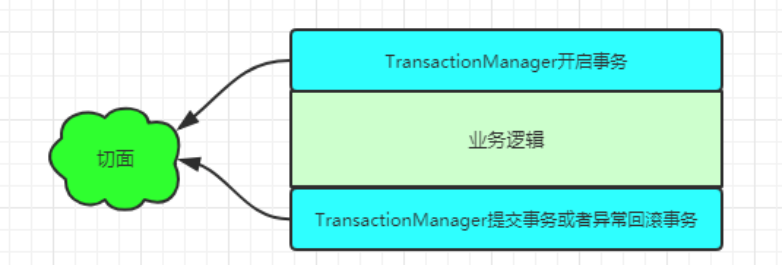@Transactional介绍
@Transactional介绍
@Transactional是spring中声明式事务管理的注解配置方式,相信这个注解的作用大家都很清楚。@Transactional注解可以帮助我们把事务开启、提交或者回滚的操作,通过aop的方式进行管理。
通过@Transactional注解就能让spring为我们管理事务,免去了重复的事务管理逻辑,减少对业务代码的侵入,使我们开发人员能够专注于业务层面开发。

我们知道实现@Transactional原理是基于spring aop,aop又是动态代理模式的实现,通过对源码的阅读,总结出下面的步骤来了解实际中,在spring 是如何利用aop来实现@Transactional的功能的。
@Transactional作用
首先是@Transactional,作用是定义代理植入点。我们知道代理对象创建的通过BeanPostProcessor的实现类AnnotationAwareAspectJAutoProxyCreator的postProcessAfterInstantiation方法来实现个,如果需要进行代理,那么在这个方法就会返回一个代理对象给容器,同时判断植入点也是在这个方法中。
那么下面开始分析,在配置好注解驱动方式的事务管理之后,spring会在ioc容器创建一个BeanFactoryTransactionAttributeSourceAdvisor实例,这个实例可以看作是一个切点,在判断一个bean在初始化过程中是否需要创建代理对象,都需要验证一次BeanFactoryTransactionAttributeSourceAdvisor是否是适用这个bean的切点。如果是,就需要创建代理对象,并且把BeanFactoryTransactionAttributeSourceAdvisor实例注入到代理对象中。
前文我们知道在AopUtils#findAdvisorsThatCanApply中判断切面是否适用当前bean,可以在这个地方断点分析调用堆栈,AopUtils#findAdvisorsThatCanApply一致调用,最终通过以下代码判断是否适用切点。
AbstractFallbackTransactionAttributeSource#computeTransactionAttribute(Method method, Class<?> targetClass) 这里可以根据参数打上条件断点进行调试分析调用栈,targetClass就是目标class …一系列调用
最终SpringTransactionAnnotationParser#parseTransactionAnnotation(java.lang.reflect.AnnotatedElement)
@Override
public TransactionAttribute parseTransactionAnnotation(AnnotatedElement ae) {
//这里就是分析Method是否被@Transactional注解标注,有的话,不用说BeanFactoryTransactionAttributeSourceAdvisor适配当前bean,进行代理,并且注入切点
//BeanFactoryTransactionAttributeSourceAdvisor
AnnotationAttributes attributes = AnnotatedElementUtils.getMergedAnnotationAttributes(ae, Transactional.class);
if (attributes != null) {
return parseTransactionAnnotation(attributes);
}
else {
return null;
}
}
上面就是判断是否需要根据@Transactional进行代理对象创建的判断过程。@Transactional的作用一个就是标识方法需要被代理,一个就是携带事务管理需要的一些属性信息。
动态代理逻辑实现
【aop实现原理分析】中知道,aop最终的代理对象的代理方法是DynamicAdvisedInterceptor#intercept,所以我们可以在这个方法断点分析代理逻辑。
@Override
public Object intercept(Object proxy, Method method, Object[] args, MethodProxy methodProxy) throws Throwable {
Object oldProxy = null;
boolean setProxyContext = false;
Class<?> targetClass = null;
Object target = null;
try {
if (this.advised.exposeProxy) {
// Make invocation available if necessary.
oldProxy = AopContext.setCurrentProxy(proxy);
setProxyContext = true;
}
// May be null. Get as late as possible to minimize the time we
// "own" the target, in case it comes from a pool...
target = getTarget();
if (target != null) {
targetClass = target.getClass();
}
//follow
List<Object> chain = this.advised.getInterceptorsAndDynamicInterceptionAdvice(method, targetClass);
Object retVal;
// Check whether we only have one InvokerInterceptor: that is,
// no real advice, but just reflective invocation of the target.
if (chain.isEmpty() && Modifier.isPublic(method.getModifiers())) {
// We can skip creating a MethodInvocation: just invoke the target directly.
// Note that the final invoker must be an InvokerInterceptor, so we know
// it does nothing but a reflective operation on the target, and no hot
// swapping or fancy proxying.
Object[] argsToUse = AopProxyUtils.adaptArgumentsIfNecessary(method, args);
retVal = methodProxy.invoke(target, argsToUse);
}
else {
// We need to create a method invocation...
retVal = new CglibMethodInvocation(proxy, target, method, args, targetClass, chain, methodProxy).proceed();
}
retVal = processReturnType(proxy, target, method, retVal);
return retVal;
}
finally {
if (target != null) {
releaseTarget(target);
}
if (setProxyContext) {
// Restore old proxy.
AopContext.setCurrentProxy(oldProxy);
}
}
}
通过分析 List<Object> chain = this.advised.getInterceptorsAndDynamicInterceptionAdvice(method, targetClass)返回的是TransactionInterceptor,利用TransactionInterceptor是如何实现代理逻辑调用的?
跟踪new CglibMethodInvocation(proxy, target, method, args, targetClass, chain, methodProxy).proceed();
发现最终是调用TransactionInterceptor#invoke方法,并且把CglibMethodInvocation注入到invoke方法中,从上面可以看到CglibMethodInvocation是包装了目标对象的方法调用的所有必须信息,因此,在TransactionInterceptor#invoke里面也是可以调用目标方法的,并且还可以实现类似@Around的逻辑,在目标方法调用前后继续注入一些其他逻辑,比如事务管理逻辑。
TransactionInterceptor–最终事务管理者
下面看代码
TransactionInterceptor#invoke
@Override
public Object invoke(final MethodInvocation invocation) throws Throwable {
// Work out the target class: may be {@code null}.
// The TransactionAttributeSource should be passed the target class
// as well as the method, which may be from an interface.
Class<?> targetClass = (invocation.getThis() != null ? AopUtils.getTargetClass(invocation.getThis()) : null);
// Adapt to TransactionAspectSupport's invokeWithinTransaction...
return invokeWithinTransaction(invocation.getMethod(), targetClass, new InvocationCallback() {
@Override
public Object proceedWithInvocation() throws Throwable {
return invocation.proceed();
}
});
}
继续跟踪invokeWithinTransaction,下面的代码中其实就可以看出一些逻辑端倪,就是我们猜想的实现方式,事务管理。
protected Object invokeWithinTransaction(Method method, Class<?> targetClass, final InvocationCallback invocation)
throws Throwable {
// If the transaction attribute is null, the method is non-transactional.
final TransactionAttribute txAttr = getTransactionAttributeSource().getTransactionAttribute(method, targetClass);
final PlatformTransactionManager tm = determineTransactionManager(txAttr);
final String joinpointIdentification = methodIdentification(method, targetClass);
if (txAttr == null || !(tm instanceof CallbackPreferringPlatformTransactionManager)) {
// Standard transaction demarcation with getTransaction and commit/rollback calls.
//开启事务
TransactionInfo txInfo = createTransactionIfNecessary(tm, txAttr, joinpointIdentification);
Object retVal = null;
try {
// This is an around advice: Invoke the next interceptor in the chain.
// This will normally result in a target object being invoked.
//方法调用
retVal = invocation.proceedWithInvocation();
}
catch (Throwable ex) {
// target invocation exception
//回滚事务
completeTransactionAfterThrowing(txInfo, ex);
throw ex;
}
finally {
cleanupTransactionInfo(txInfo);
}
//提交事务
commitTransactionAfterReturning(txInfo);
return retVal;
}
else {
// It's a CallbackPreferringPlatformTransactionManager: pass a TransactionCallback in.
try {
Object result = ((CallbackPreferringPlatformTransactionManager) tm).execute(txAttr,
new TransactionCallback<Object>() {
@Override
public Object doInTransaction(TransactionStatus status) {
TransactionInfo txInfo = prepareTransactionInfo(tm, txAttr, joinpointIdentification, status);
try {
return invocation.proceedWithInvocation();
}
catch (Throwable ex) {
if (txAttr.rollbackOn(ex)) {
// A RuntimeException: will lead to a rollback.
if (ex instanceof RuntimeException) {
throw (RuntimeException) ex;
}
else {
throw new ThrowableHolderException(ex);
}
}
else {
// A normal return value: will lead to a commit.
return new ThrowableHolder(ex);
}
}
finally {
cleanupTransactionInfo(txInfo);
}
}
});
// Check result: It might indicate a Throwable to rethrow.
if (result instanceof ThrowableHolder) {
throw ((ThrowableHolder) result).getThrowable();
}
else {
return result;
}
}
catch (ThrowableHolderException ex) {
throw ex.getCause();
}
}
}
分析源码后

介绍一下Spring事务的传播行为:
所谓事务的传播行为是指,如果在开始当前事务之前,一个事务上下文已经存在,此时有若干选项可以指定一个事务性方法的执行行为。在TransactionDefinition定义中包括了如下几个表示传播行为的常量:
- TransactionDefinition.PROPAGATION_REQUIRED:如果当前存在事务,则加入该事务;如果当前没有事务,则创建一个新的事务。这是默认值。
- TransactionDefinition.PROPAGATION_REQUIRES_NEW:创建一个新的事务,如果当前存在事务,则把当前事务挂起。
- TransactionDefinition.PROPAGATION_SUPPORTS:如果当前存在事务,则加入该事务;如果当前没有事务,则以非事务的方式继续运行。
- TransactionDefinition.PROPAGATION_NOT_SUPPORTED:以非事务方式运行,如果当前存在事务,则把当前事务挂起。
- TransactionDefinition.PROPAGATION_NEVER:以非事务方式运行,如果当前存在事务,则抛出异常。
- TransactionDefinition.PROPAGATION_MANDATORY:如果当前存在事务,则加入该事务;如果当前没有事务,则抛出异常。
- TransactionDefinition.PROPAGATION_NESTED:如果当前存在事务,则创建一个事务作为当前事务的嵌套事务来运行;如果当前没有事务,则该取值等价于TransactionDefinition.PROPAGATION_REQUIRED。
失效:
-
未被spring管理的类。
-
final修复方法,会失效。
@Service
public class OrderServiceImpl {
@Transactional
public final void cancel(OrderDTO orderDTO) {
// 取消订单
cancelOrder(orderDTO);
}
}
OrderServiceImpl的cancel取消订单方法被final修饰符修饰,Spring事务底层使用了AOP,也就是通过JDK动态代理或者cglib,帮我们生成了代理类,在代理类中实现的事务功能。但如果某个方法用final修饰了,那么在它的代理类中,就无法重写该方法,从而无法添加事务功能。这种情况事务就会在Spring中失效。
- try catch内部捕获异常,没有正常抛出异常情况失效。
- 在@Transactional注解的方法中,再调用本类中的其他方法method2时,那么method2方法上的@Transactional注解是不!会!生!效!的!但是加上也并不会报错,拿图片简单帮助理解一下吧。这一点也是面试中会问到的事务失效的场景。
- 方法必须是public修饰符。
- 同一个类中的方法相互调用。
@Service
public class OrderServiceImpl extends ServiceImpl<OrderMapper, Order> implements IOrderService {
@Autowired
private OrderMapper orderMapper;
@Autowired
private ProductMapper productMapper;
@Override
public ResponseEntity submitOrder(Order order) {
// 保存生成订单信息
long orderNo = Math.abs(ThreadLocalRandom.current().nextLong(1000));
order.setOrderNo("ORDER_" + orderNo);
orderMapper.insert(order);
// 扣减库存
this.updateProductStockById(order.getProductId(), 1L);
return new ResponseEntity(HttpStatus.OK);
}
@Transactional(propagation = Propagation.REQUIRES_NEW)
public void updateProductStockById(Integer num, Long productId) {
productMapper.updateProductStockById(num, productId);
}
}
- 方法的事务传播类型不支持事务。
@Service
public class OrderServiceImpl extends ServiceImpl<OrderMapper, Order> implements IOrderService {
@Autowired
private OrderMapper orderMapper;
@Autowired
private ProductMapper productMapper;
@Override
@Transactional(propagation = Propagation.REQUIRES_NEW)
public ResponseEntity submitOrder(Order order) {
long orderNo = Math.abs(ThreadLocalRandom.current().nextLong(1000));
order.setOrderNo("ORDER_" + orderNo);
orderMapper.insert(order);
// 扣减库存
this.updateProductStockById(order.getProductId(), 1L);
return new ResponseEntity(HttpStatus.OK);
}
/**
* 扣减库存方法事务类型声明为NOT_SUPPORTED不支持事务的传播
*/
@Transactional(propagation = Propagation.NOT_SUPPORTED)
public void updateProductStockById(Integer num, Long productId) {
productMapper.updateProductStockById(num, productId);
}
}
- 数据库不支持事务。
- 未配置开启事务。
- 多线程调用。
@Service
public class OrderServiceImpl {
@Autowired
private OrderMapper orderMapper;
@Autowired
private MessageService messageService;
@Transactional
public void orderCommit(orderModel orderModel) throws Exception {
orderMapper.insertOrder(orderModel);
new Thread(() -> {
messageService.sendSms();
}).start();
}
}
@Service
public class MessageService {
@Transactional
public void sendSms() {
// 发送短信
}
}





【推荐】国内首个AI IDE,深度理解中文开发场景,立即下载体验Trae
【推荐】编程新体验,更懂你的AI,立即体验豆包MarsCode编程助手
【推荐】抖音旗下AI助手豆包,你的智能百科全书,全免费不限次数
【推荐】轻量又高性能的 SSH 工具 IShell:AI 加持,快人一步
· 无需6万激活码!GitHub神秘组织3小时极速复刻Manus,手把手教你使用OpenManus搭建本
· C#/.NET/.NET Core优秀项目和框架2025年2月简报
· Manus爆火,是硬核还是营销?
· 终于写完轮子一部分:tcp代理 了,记录一下
· 【杭电多校比赛记录】2025“钉耙编程”中国大学生算法设计春季联赛(1)